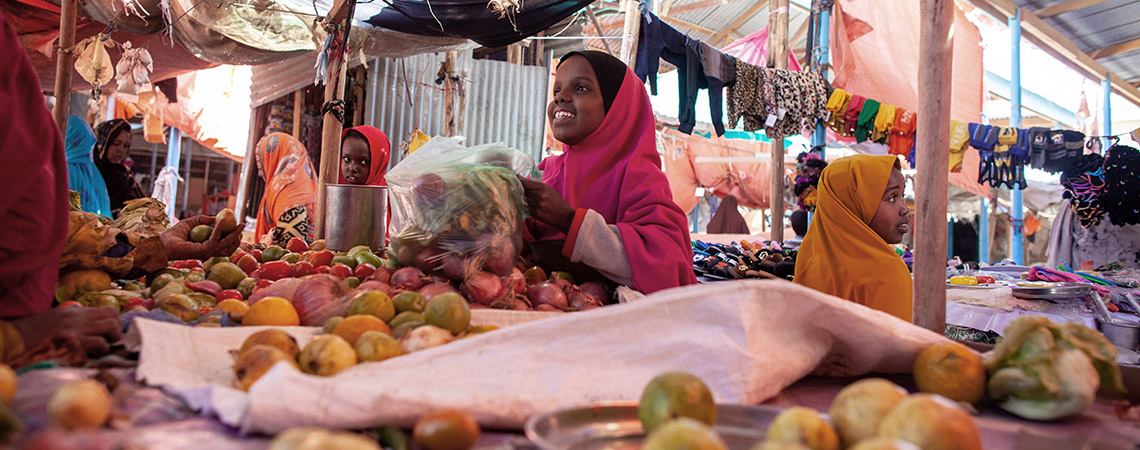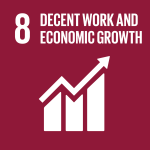
Photo:
Climate change poses several hazards and risks to urban areas in Somalia, exacerbating existing vulnerabilities and threatening the livelihoods of millions of people. Rising temperatures are expected to intensify heatwaves, leading to heat-related illnesses and increased strain on already limited water resources. Increased frequency and intensity of droughts will further strain water availability, agricultural productivity, and food security, impacting urban populations reliant on rural food sources. Sea-level rise and coastal erosion threaten coastal cities like Mogadishu.
According to the ND-Gain Index, Somalia is the most vulnerable country globally to climate change and one of the least ready for its impacts due to inadequate adaptation strategies and absence of climate-resilient planning and action within multi-sectoral institutions and policies, infrastructures, innovation, and services.
Moreover, over three decades of conflict have fractured Somalia, dismantling its institutions, deepening poverty, and increasing vulnerability. The impacts of climate change have exacerbated existing vulnerabilities and social marginalization, and have induced massive displacement, with the majority of displaced women and children.
With funding from the GEF-Least Developed Countries Fund, and more than $37 million in mobilized co-finance, the proposed 5-year project (2025 – 2030) aims to enhance resilience in Somalia’s urban areas (where 45 percent of the national population – 6.45 million or more people – live) through a systematic, gender-responsive and integrated adaptation approach, coordinating with multiple levels of governance to implement national strategies effectively.
To be implemented by UNDP in partnership with key institutions and ministries at the national, sub-national and target district municipalities, it will focus on strengthening the livelihoods and resilience of communities, especially women and youth, using nature-based solutions. Collaboration with the private sector will be key to addressing the drivers of degradation and to promoting sustainable alternative livelihoods, with an emphasis on productive and green enterprise development including for women-led MSMEs. Innovative finance mechanisms will be utilized to attract private sector investments towards resilience-building.
- Community
- Municipality
- District
- National
- Local Governments
- National Governments
- Non-Governmental Organizations
- Private Sector Partners
- United Nations Development Programme (UNDP)
Approximately 852,877 direct beneficiaries (426,438 men; 426,439 women)
- United Nations Development Programme (UNDP)
- Global Environment Facility (GEF)
- Government of Somalia
Expected outcomes
Outcome 1. Enhanced institutional capacity for climate risk management and spatial planning for the adoption of nature-based solutions (NbS) in climate resilient urban planning at national, sub-national and local levels.
Outcome 2. NbS uptake in urban areas at sub-national and local levels are increased.
Outcome 3. Innovative financing architecture is available to incentivize private sector investment in climate-resilient and NbS technologies, and enterprises.
Outcome 4. Improved sustainability of adaptation actions, replication of NbS in urban areas
- Image

- Image

- Image

- Image

- Image

- Image

- Image

Somalia faces a range of climate-related hazards, exacerbating existing vulnerabilities and posing significant risks to communities, particularly IDPs, women and youth.
The country has witnessed a growing urbanization, with a large influx of people into cities. Unplanned urban expansion often occurs in hazard-prone areas, such as floodplains or coastal regions, exposing communities to heightened risk of natural disasters like floods, storms and landslides. Many urban centers have expanded without adequate consideration for environmental sustainability, resilience and effective disaster preparedness and response mechanisms. The absence of comprehensive land-use planning and enforcement of building codes further compounds these risks, leaving communities vulnerable to the impacts of climate change and environmental degradation.
Urban resilience requires urban institutions that can effectively manage competing priorities while also adjusting to emerging needs. In a dynamic institutional landscape, the responsibility for climate resilience isn't solely vested in one specific department or unit; rather, it's dispersed across both national and sub-national governments. The challenge for Somalia lies in achieving coordination and coherence amidst this intricate institutional framework, which warrants significant attention, as well as an inclusive approach which is gender responsive.
The intricate array of challenges leading to this vulnerability also encompasses factors such as the inadequate incorporation of nature-based solutions (NbS) in urban planning. Contributing to these issues are underlying factors like prolonged conflict and political instability, which have impeded effective governance and planning. The lack of a stable political environment impedes the implementation of long-term, sustainable urban development strategies, leaving cities more susceptible to vulnerabilities. Moreover, persistent poverty, unemployment, and lack of access to basic services further contribute to this vulnerability. Moreover, climate change exacerbates socio-economic inequalities within urban communities, disproportionately affecting marginalized groups such as the urban poor and IDPs. These vulnerable populations often reside in informal settlements with inadequate housing and limited access to basic services, making them particularly susceptible to the impacts of climate-related disasters. Women, who often bear the primary responsibility for household chores, water collection, and food provision, find themselves disproportionately affected by these challenges.
Preferred solution
The preferred solution will enhance climate resilience in urban areas by supporting NbS and improving land and natural resource management. This will be achieved by integrating economic incentives – like livelihood support and capacity, financial and technical support to MSME, with targeted support to women-led MSMEs – and improved technologies that can both reduce pressure on natural resources and lower vulnerability to climate hazards.
Under the project interventions, a coordination body will be implemented to both bridge the line ministries with the federal government, local institutions and municipalities, as well as the most vulnerable groups to engage in climate-smart and sustainable livelihoods. Moreover, the project will create opportunities for MSME development an facilitate private investment into climate resilient resource management, NbS and livelihoods.
The project will address the interconnected issues of water and land management, urban resilience through a systems-based approach. This involves improved land and water resource management, at community, federal and provincial levels as well as channelling public and private sector investments towards climate resilient development. Building positive synergies between ongoing projects, initiatives and systems will facilitate integrated and coherent planning and investment at the landscape level to improve urban planning, as well as implementation, monitoring and evaluation of adaptation solutions in the target area. The project will promote gender equality and women’s empowerment, with women and youth engaged as agents of change. This is also in line with Somalia’s NDC which notes that “gender equality is critical for effective climate adaptation and mitigation in Somalia .”
By implementing improved resource management and enabling sustainable community livelihoods, the project will strengthen community resilience to the impacts of climate change induced droughts, floods, sea level rise, and heat island effects. As a core element, the preferred solution will prioritise community ownership of locally led adaptation solutions, thereby ensuring every intervention is sustainable and can be continued in the long term. Further to this, the interventions of the proposed project will form the basis of an integrated strategy that will catalyse future investments into climate resilience beyond the project’s lifespan, laying the foundation for upscaling throughout Somalia and the region.
Outcome 1. Enhanced institutional capacity for climate risk management and spatial planning for the adoption of nature-based solutions (NbS) in climate resilient urban planning at national, sub-national and local levels.
Output 1.1. Multi-sectoral coordination body established with gender parity to build institutional capacity for cross-sectoral coordination and decision making in support of integrated climate resilient Urban planning with NBS as a one key adaptation approach.
Output 1.2. NbS for climate resilience promoted in vulnerable urban areas through trainings, including on spatial planning and use of data, knowledge transfer and improved awareness at national, sub-national and local levels ensuring the active involvement and leadership of women.
Output 1.3 Strengthened coherence within the policy framework through updates to policies to enable climate risk informed urban planning at national, regional and local levels
Output 1.4 Gender and IDP responsive climate adaptation and climate risk multi-sectoral plans, including integration of relevant NbS approaches to inform on-the-ground interventions developed.
Outcome 2. NbS uptake in urban areas at sub-national and local levels are increased.
Output 2.1. Improved resilience in urban areas through gender-responsive spatial planning for targeted adoption of NbS to reduce flood hazards, improved water resource and drought management.
Output 2.2. Sponge city concept, green spaces and corridors (as part of NBS) implemented in target sites to reduce urban heat stress, increase water absorption and reduced flood risks.
Outcome 3. Innovative financing architecture is available to incentivize private sector investment in climate-resilient and NbS technologies, and enterprises.
Output 3.1. Sustainable climate-resilient and NbS enterprise development in targeted areas through provision of training, including gender responsive training modules and guidance tools for increased technical and financial capacities of MSMEs.
Output 3.2. Assessing the absorptive capacity and needs of MSMEs including women led enterprises to operate on urban adaptation.
Output 3.3. Establishment of financing facility for MSMEs, to integrate NbS and green entrepreneurship, with a particular emphasis on supporting women entrepreneurs.
Output 3.4 Technical assistance provided to private sector stakeholders to ensure sustainability and scalability of private sector engagement
Outcome 4. Improved sustainability of adaptation actions, replication of NbS in urban areas
Output 4.1. Communication strategy and knowledge sharing platform established inclusive dissemination of information to enable community engagement, ensuring the integration of women’s perspectives and experiences.
Output 4.2. Monitoring, evaluation and data collection for effectiveness of policies, institutional capacity strengthening and NBS interventions.
A monitoring and evaluation (M&E) plan will be prepared at PPG stage and validated at the inception of project implementation, and periodically reviewed and adjusted to respond to the project context. The project results, corresponding indicators and mid-term and end-of-project targets in the project results framework will be monitored annually and evaluated during project implementation.
Project-level monitoring and evaluation will be undertaken in compliance with UNDP requirements as outlined in the UNDP POPP and UNDP Evaluation Policy. The UNDP Country Office is responsible for ensuring full compliance with all UNDP project monitoring, quality assurance, risk management, and evaluation requirements. Activities under the M&E component will include the hosting of an Inception Workshop (and development of the associated report); producing annual GEF Project Implementation Reports (PIRs); monitoring of Social and Environmental Safeguards Screening, stakeholder engagement and gender action plans; supervised site visits and on-the-ground assessments; an Independent Mid-term Review (MTR); and a Terminal Evaluation (TE).
Mr. Benjamin Basmaci, Regional Technical Specialist, Climate Change Adaptation, UNDP benjamin.basmaci@undp.org

